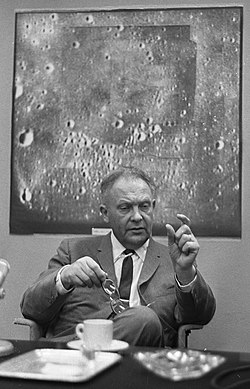Gerald Kuiper
| Gerard Kuiper | |
|---|---|

Gerard Kuiper in 1964
|
|
| Born |
Gerrit Pieter Kuiper December 7, 1905 Tuitjenhorn, Netherlands |
| Died | December 23, 1973 (aged 68) Mexico City, Mexico |
| Cause of death | Heart attack |
| Nationality | Dutch–American |
| Alma mater |
Leiden University (Bachelor of Science, Master of Science, Master of Physics, Doctor of Philosophy, Doctor of Science) |
| Occupation |
Astronomer Planetary scientist Selenographer Author Professor |
| Years active | 1933–1973 |
| Known for | Kuiper belt |
| Spouse(s) | Sarah Fuller (1936–1973; his death) |
Gerard Peter Kuiper (English: /ˈkaɪpər/; Dutch pronunciation: [ˈkœypər]; born Gerrit Pieter Kuiper; December 7, 1905 – December 23, 1973) was a Dutch–American astronomer, planetary scientist, selenographer, author and professor. He is the eponymous namesake of the Kuiper belt. Kuiper is considered by many to be the father of modern planetary science. As professor at the University of Chicago, he was dissertation advisor to Carl Sagan. In 1958, the two worked on the classified military Project A119, the secret Air Force plan to detonate a nuclear warhead on the Moon.
Kuiper, the son of a tailor in the village of Harenkarspel in North Holland, had an early interest in astronomy. He had extraordinarily sharp eyesight, allowing him to see magnitude 7.5 stars with the naked eye, about four times fainter than visible to normal eyes. He went to study at Leiden University in 1924, where at the time a very large number of astronomers had congregated. He befriended fellow students Bart Bok and Pieter Oosterhoff and was taught by Ejnar Hertzsprung, Antonie Pannekoek, Willem de Sitter, Jan Woltjer, Jan Oort and the physicist Paul Ehrenfest. He received his B.Sc. in Astronomy in 1927 and continued straight on with his graduate studies. Kuiper finished his doctoral thesis on binary stars with Hertzsprung in 1933, after which he traveled to California to become a fellow under Robert Grant Aitken at the Lick Observatory. In 1935 he left to work at the Harvard College Observatory where he met Sarah Parker Fuller, whom he married on June 20, 1936. Although he had planned to move to Java to work at the Bosscha Observatory, he took a position at the Yerkes Observatory of the University of Chicago and became an American citizen in 1937. In 1949, Kuiper initiated the Yerkes–McDonald asteroid survey (1950–1952).
...
Wikipedia
